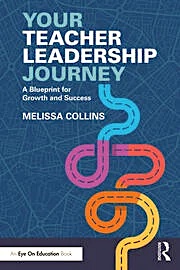A Leadership Blueprint for Growth and Success
Your Teacher Leadership Journey: A Blueprint for Growth and Success
By Melissa Collins
(Routledge/Eye On Education, 2023 – Learn more)
Reviewed by Stacy Haynes-Moore

As I prepped for Day 2 of the lesson, bolstered by success, my confidence was well-timed with a scheduled observation from my instructional coach. However, that second day was rough – reallllyyyy off point, one of those teaching moments that I imagine that you, fellow colleagues, may recognize with a bit of empathy.
My plans wobbled while the coach was there. Students did not easily engage, some books remained in their backpacks, and I noticed few notes jotted. I adjusted my strategies and lesson on the fly, as we do in a with-it-ness response to students, and in the attempt to resuscitate the learning. I anticipated that my mentor observer would soon deconstruct my missed moves and tell me how to improve.
Unfortunately, I did not have a Groundhog Day redo; what I did have, though, was a discovery that the instructional coach was a thoughtful mentor. She listened carefully. She asked open-ended questions. She also offered feedback at appropriate turns in the post-lesson conversation. In all, this was a purposeful and helpful discussion, my “bad day” notwithstanding.
Learning what leadership is all about

Collins’ book identifies a range of qualities desirable for teacher leaders – educators in K-12 schools who, as Collins makes sure to emphasize, are not only those in officially designated leadership roles, but inclusive of any educator who exudes a passion for learning, chooses to advocate for students, and cares about the future of teaching and their teaching colleagues.
Collins argues that in today’s polemic social and political world, “when good teachers are in short supply and quitting every day, it has never been more important for people like you and me to learn what teacher leadership is all about” (p. 10). Such is the core of Collins’ book.
I read from my perspective as a longtime secondary teacher, and I also have served as an instructional coach and curriculum facilitator. Today I am a professor of pre-service educators. Reflectively, no matter what role of leadership you may have as a teacher/leader reading this book, there’s a chapter worth your time to read and reflect upon.
Mentors, instructional coaches, building principals, district facilitators, and those leading from central office can all benefit from Collins’ experiences and guidance.
Following the development of teacher leadership
The book is reader-friendly. Its five sections are fairly concise: What is a Teacher Leader, Becoming a Teacher Leader, Evolving as a Teacher Leader, Thriving as a Teacher Leader, and Developing Teacher Leaders.
The reading could be used for a shared study and team conversation such as a department or PLC. Or it could be used for individual self-reflection. Chapters close with a brief summary and some questions/prompts that can spark discussion or writing.
Overall, Collins’ ideas, and several of her suggested lists to use for self-evaluation, do not need to be taken up in one fell swoop. Rather, this book may best be read in single chapters and stashed on our shelves to return to periodically as our leadership pathway develops.
Collins is an elementary teacher for Tennessee schools and shares details of her admirable career – one that connects with STEM, involvement, with educational advocacy, with leadership in professional organizations, and includes honors like the Presidential Award for Excellence in Science Teaching.
Often Collins shows vulnerability about her teaching experiences or decisions made along the way of her career path. In many chapters, she also references interviews with a small cohort of teachers, and their voices expand upon the many views and understandings of teacher leadership roles.
Collins invites us to be reflective educators. Several chapters, particularly those in section Part II: Becoming a Teacher Leader, speak to responsibilities of formal leadership roles. This section may carry the most impact for a shared team reading, as Collins examines issues such as finding peer mentors, navigating professional relationships with administrators, and developing long-lasting dispositions to grow as stronger teachers.
Roles beyond the classroom
School PLC members, instructional coaches, or district team leaders might dig right in with the chapter “The Goal, Not the Role” to discuss and reflect upon what, how, and why we choose to lead. Meanwhile, building principals or district administrators might be more immediately drawn to reading Part V with its emphasis on developing and sustaining the pipeline of teacher leaders. Chapter 15 “How to Champion Teacher Leaders” underscores the necessity for building leaders to think thoughtfully and creatively about showing professional support for teaching staff.
Regardless, each chapter offers a range of ideas to be valued. As I read Collins’ book and reflected on my own path in school teaching and leadership, I am reminded of my mishaps and successes and ways that I’ve shifted in my professional goals and intentions throughout the years.
Collins’ stories and her encouraging guidance reminds me of the many individuals in leadership roles along my way that enabled me to become a better teacher for my students and colleagues.
Dr. Stacy Haynes-Moore is a veteran classroom teacher for K-12 schools and has served district colleagues in various leadership roles, including that of instructional coach and curriculum facilitator for grades 6-12 English Language Arts. She currently carries forward her passion for teaching, learning, and leading as Assistant Professor in Teacher Education at Coe College.






























